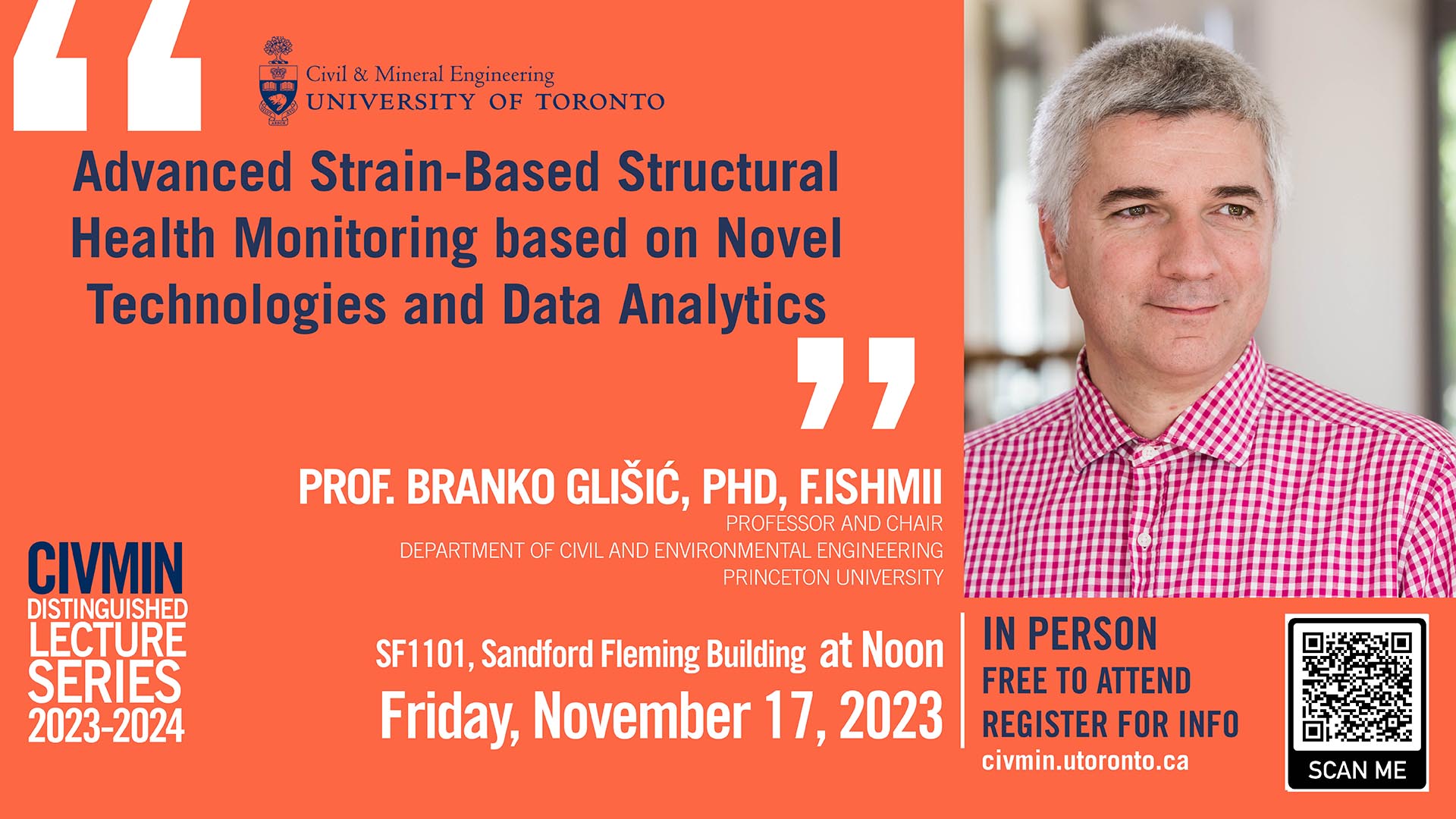- Location
- SF1101, Sandford Fleming Building
- Series/Type
- Lecture
- Format
- In-Person
- Dates
- November 17, 2023 from 12:00pm to 1:30pm
Links
Advanced Strain-Based Structural Health Monitoring based on Novel Technologies and Data Analytics
CivMin Distinguished Lecture Series
by Prof. Branko Glisic
Chair and Professor of
Civil and Environmental Engineering
Princeton University
Friday, November 17, 2023
Time: Noon
Location: SF1101, Sandford Fleming Building
10 King’s College Road, University of Toronto
IN-PERSON LECTURE
FREE TO ATTEND
PLEASE REGISTER IN ADVANCE
A REMINDER WILL BE SENT VIA EMAIL
ABSTRACT
Civil structures and infrastructure (structures) are inevitably subjected to damage and deterioration caused by natural or human-induced actions. Sustainable construction, preservation, maintenance, renewal, and repurposing of structures are becoming key challenges in modern society. Structural Health Monitoring (SHM) is a process aimed at providing actionable information on structural health condition and performance, which in turn can be used to address the above challenges. SHM can be viable solution only if it can guarantee sufficient sensitivity to damage and deterioration, reliable high-quality data in long terms, and interpretability of long-term data. These challenges are particularly present in concrete structures, where thermal and rheological strain (creep and shrinkage) tend to confuse usual structural behaviors with damage and deterioration. This seminar presents innovative technologies that can enable high sensitivity to damage and deterioration in long term: discrete long-gauge fiber-optic strain sensors, 1D distributed fiber-optic strain sensors, and novel 2D sensing sheets based on large-area electronics. In addition, advanced algorithms based on statistics and machine learning for evaluation of data reliability and long-term data analysis are presented. Novel technologies and algorithms were implemented and validated on a real structure, Streicker Bridge on Princeton University campus, instrumented with fiber optic strain sensors during its construction in 2009.
BIO
Prof. Branko Glišić, received his degrees in Civil Engineering and Theoretical Mathematics at the University of Belgrade, Serbia, and Ph.D. at the EPFL, Switzerland. After eight-year experience at SMARTEC, Switzerland, where he was involved in numerous Structural Health Monitoring (SHM) projects, he has been employed as a faculty member at the Department of Civil and Environmental Engineering of Princeton University, where he is currently serving as the Chair. His research is in the areas of SHM, Smart Structures, Heritage Structures, and Engineering and the Arts.
Prof. Glišić’s research includes: long-gauge and distributed fiber optic sensors, 2-D sensors based on large area electronics, and 3-D sensors based on radio-frequency devices and ground penetrating radar; advanced data analysis for diagnostics, prognostics, and decision-making based on structural analysis, machine learning and hybrid physics-informed machine learning; documentation, integration and visualization using virtual tours, information modelling, and augmented reality; smart, kinetic, deployable, and adaptable structures; heritage structures, and engineering and the arts in general. His application domains include concrete, steel, and masonry structures: bridges, buildings, pipelines; smart structures for coastal protection; and historical buildings, monuments, and sites.
Prof. Glišić is author and co-author of 100+ published papers, short courses on SHM, and the book “Fibre Optic Methods for Structural Health Monitoring”. He is Council Member and fellow of ISHMII, voting member of ACI committee 444, and member of several other professional associations and journal editorial boards. Prof. Glišić is recipient of several awards including prestigious SHM Person of the Year Award and ASCE Moisseiff Award.
